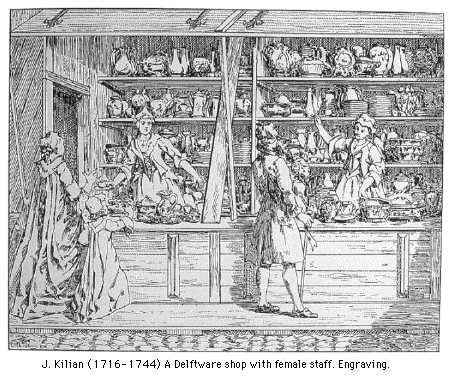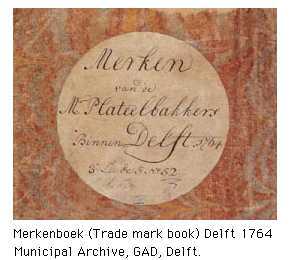 Posteleyne
/ Vergulde Astonne
Posteleyne
/ Vergulde Astonne Posteleyne
/ Vergulde Astonne
Posteleyne
/ Vergulde Astonne
5. Drie Posteleyne Astonne aka Drie Porceleine Astonnen aka Drie Vergulde Astonnekens - The Porcelain Ashton / Les trois tonneaux de cendre (workshop active from 1655 - 1803 or 1804). Address is Lange Geer 32-36, stretching in the back all the way to Achterom 54-56. 'Names of houses' file mentions it as run by Jeronium Pietersz van Kessell, sold 1744 onder the first name; sold again in 1804-1805 under the latter name. Delft blue workshop.
Delftware Connoisseurship
A serious collector of Delftware will attempt to identify and date the object. On Delft blue plates and other Delftware objects such as jugs, a potters mark may give a first indication. One should always treat potters marks with caution. Marks must be considered as just one indication.
Masters & apprentices
All masters and apprentices working at this workshop had to be inscribed in the Delft St Luke Guild Book. In 1877 this book was published in a 120 page text by Obreen. In 2002 this text has been scanned and is now available and fully searcheable on this internet site. See the yellow field on top; first click the heading Delft Artists & Patrons and then click Obreen. The full text is in Dutch. Spelling varies; in order to find masters or apprentices of a faience workshop (plattielbackers, plateelbacker, platielbacker) search for the letters "plat".

Vase in Rijksmuseum. China-style design made by Astonnekens workshop.

Translation from Trade mark book, 1752: "I the undersigned, faience baker in this town declare here, that there is a sign in the facade of my home and workshop, the so called Three Porcelain Ashbins, which is also customarily used to sign on the back of the goods produced by us."

 Full
presentation at http://www.xs4all.nl/~kalden
Email the author at kalden@xs4all.nl
Full
presentation at http://www.xs4all.nl/~kalden
Email the author at kalden@xs4all.nl
All questions about identifying, dating, valuing, buying and selling: please go to www.Aronson.nl.
Notes: Thanks to the Delft Archives Staff for their help and enthusiasm. A well researched two volume book on Delftware is Marion S. van Aken-Fehmers et al, Delfts Aardewerk, Geschiedenis van een nationaal product, published jointly by Waanders, Zwolle & Gemeentemuseum, Den Haag, 1999 (part 1) and 2001 (part 2). Mark shown in Jean Justice, 'Dictionaire des marques et monogrammes de la faience de Delft', Gand/Gent 1901.
How did they make Delft blue faience? text in English
Hoe maakte men Delfts blauw plateel? Tekst in het Nederlands.
Visit The Hague municipal Gemeentemuseum site on Delft Blue.
Launched January 2002. Last update 25 October 2016.